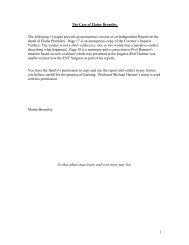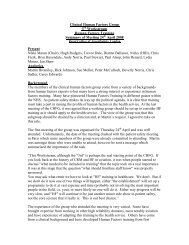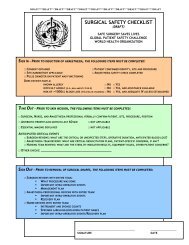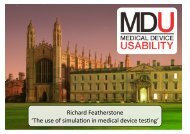The Essentials of Patient Safety - Clinical Human Factors Group
The Essentials of Patient Safety - Clinical Human Factors Group
The Essentials of Patient Safety - Clinical Human Factors Group
You also want an ePaper? Increase the reach of your titles
YUMPU automatically turns print PDFs into web optimized ePapers that Google loves.
<strong>The</strong> <strong>Essentials</strong> <strong>of</strong> <strong>Patient</strong> <strong>Safety</strong><br />
drug interactions and saved nurse time. Finally, the patients themselves were engaged<br />
in the process. Each patient admitted to the hospital is now given a Medication <strong>Safety</strong><br />
Brochure that provides advice for them and a form on which to list their current<br />
medication. <strong>Patient</strong>s are also actively encouraged to check with staff if they have been<br />
<br />
patients leaving hospital returned to the medication appropriate to their life at home.<br />
Technological innovations, in the form <strong>of</strong> automated medication dispensing machines,<br />
formed the next phase <strong>of</strong> the drive to further reduce errors.<br />
Using information technology to reduce medication error<br />
Information technology can reduce error in a number <strong>of</strong> different ways: improving<br />
communication, making knowledge more readily accessible, prompting for key pieces<br />
<strong>of</strong> information (such as the dose <strong>of</strong> a drug), assisting with calculations, monitoring<br />
and checking in real time, and providing decision support(6). Many medication errors<br />
occur because clinicians do not have the necessary information about either the<br />
patient <strong>of</strong> the drug or because test results are not available. Hand written<br />
prescriptions, transcribing errors and calculation mistakes are also major problems.<br />
Several medication technology systems have been developed to address these and<br />
other problems operating at various stages <strong>of</strong> the medication and delivery process.<br />
<strong>The</strong>y show great promise but, as David Bates warns, are not a panacea:<br />
<br />
the net effect is not entirely predictable, and it is vital to study the impact <strong>of</strong><br />
these technologies. <strong>The</strong>y have their greatest impact in organizing and making<br />
available information, in identifying links between pieces <strong>of</strong> information, and<br />
in doing boring repetitive tasks, including checks for problems. <strong>The</strong> best<br />
medication processes will thus not replace people but will harness the<br />
strengths <strong>of</strong> information technology and allow people to do the things best<br />
done by people, such as making complex decisions and communicating with<br />
(7).<br />
<strong>The</strong> system that has probably had the largest impact on medication error is<br />
computerized physician order entry (CPOE), in which medication orders are written<br />
online. This improves orders in several ways. First, they are structured, so they must<br />
include a drug, dose and frequency; the computer, unlike a person, can refuse to<br />
accept any order without this information. <strong>The</strong>y are always legible, and the clinician<br />
making the order can always be identified if there is a need to check back. Finally, all<br />
orders can be routinely and automatically checked for allergies, drug interactions,<br />
<br />
liver and kidney function. <strong>Clinical</strong> staff may fear that these advantages may be <strong>of</strong>fset<br />
by the time lost in typing rather than writing orders, but in practice there is minimal<br />
difference (9).<br />
Bates and his colleagues (10) showed that the introduction <strong>of</strong> a computerised<br />
order entry system resulted in a 55% reduction in medication errors. This system<br />
provided clinicians with information about drugs, including appropriate constraints on<br />
choices (dose, route, frequency) and assistance with calculations and monitoring.<br />
With the addition <strong>of</strong> higher levels <strong>of</strong> decision support, in the form <strong>of</strong> more<br />
comprehensive checking for allergies and drug interactions, there was an 83%<br />
reduction in error. Other studies have shown improvement <strong>of</strong> prescribing <strong>of</strong><br />
33








